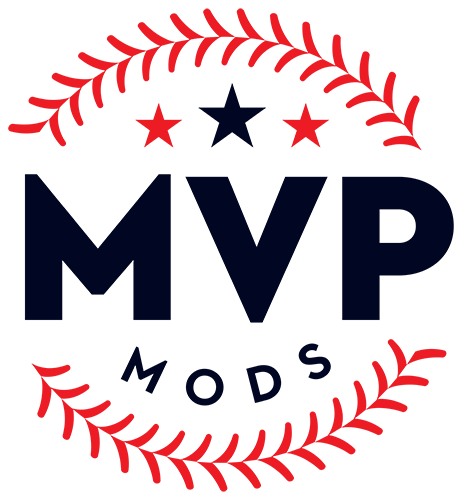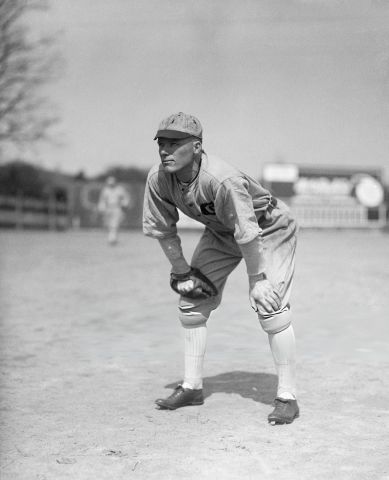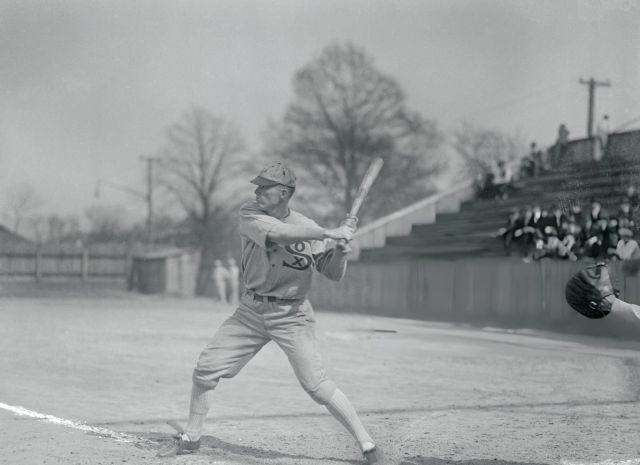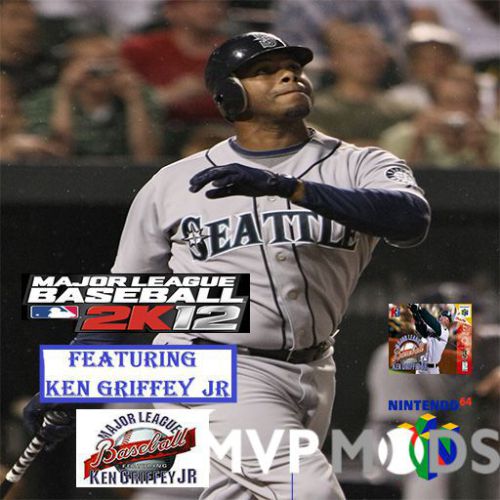Bibb Falk
It almost seems as if everyone is short-changing Bibb Falk. Many articles describe him as “the man who replaced Joe Jackson.” Author William A. Cook used that same description when he wrote Falk’s biography in 2015. There are very few players who could literally replace Shoeless Joe. Falk should be recalled as a player who had a fine career in his own right. In 12 seasons with the Chicago White Sox and Cleveland Indians, Falk batted .314 and compiled an on-base percentage of .372. For four consecutive seasons he led American League outfielders in assists from his left field position.
Falk was also one of the most successful managers on the collegiate level at the University of Texas. In his 25 years of piloting the Longhorns, he won 20 Southwestern Conference Championships and two National Championships. He did it with the deftness of a drill sergeant and an acerbic tongue that earned him the nickname “Jockey” for the hard way he rode opponents.
Bibb August Falk was born on January 27, 1899, in Austin, Texas. He was the fourth of six children born to Gustave and Christine Falk, both of whom who had emigrated from Sweden. His younger brother, Chet Falk, was a pitcher for the St. Louis Browns from 1925 to 1927.
Falk graduated from Stephen F. Austin High School in 1916. His plan was to follow his father and work for the railroad. But University of Texas baseball coach William J. “Uncle Billy” Disch saw Falk play in high school and convinced him to play football and baseball at Texas, where Disch was already a coaching legend. Falk was a two-sport star at UT, excelling as an All-Southwest Conference tackle on the gridiron and a pitcher for the baseball team. In three varsity seasons, he was undefeated as a starting pitcher. When he was not on the mound, Bibb played first base and the outfield for the Longhorns. In his three seasons beginning in 1917, he batted .369, .460 and .400. When America entered World War I, Falk joined the U.S. Naval Reserves.
During the 1919 season, the White Sox contacted Falk about joining their team. Chicago trained in Mineral Wells, Texas, and on occasion would play exhibition games against the Longhorns. Falk caught the attention of the White Sox management, who sought to sign him to a contract. “Well, it was settled by wire and mail between the White Sox, Disch and myself,” said Falk. “They just sent a contract down here after school that summer. I signed in the summer before I reported. In those days you could do that in college, you know. So, I actually signed the contract in the summer of ’19 and reported in June of ’20.” The contract Falk signed was for $2,500 and a $1,000 bonus. He returned to Texas and graduated with a degree in civil engineering, then joined the White Sox and made his major league debut on July 17 against the New York Yankees at the Polo Grounds. He pinch hit for Eddie Cicotte and lined out to center field.
By then, another story was brewing on the South Side. The White Sox, who had won the American League pennant in 1919, lost to Cincinnati in the World Series. Despite their being the heavy betting favorites, it was suspected and subsequently determined that they had not made a genuine effort to win the championship. Whispers turned to rumors which proved to have enough fact behind them that an investigation was launched as part of a general investigation of gambling in baseball toward the end of the 1920 season.
In the end, seven White Sox players (first baseman Chick Gandil did not report for the 1920 season) were involved. Following indictments from the Cook County grand jury, Chicago owner Charles Comiskey issued an indefinite suspension to each player, thus decimating his club. The last game the White Sox had played with their team fully intact was on September 27, a 2-0 win over Detroit. At that moment, the Sox were a half game behind first-place Cleveland in the American League standings.
But Cleveland completed a four-game sweep against St. Louis and split a four-game season-ending series with Detroit. Chicago closed out on the road in St. Louis. Fielding mostly replacement players, the Sox lost two of three games to the Browns. “I never really knew much about it [the Series fix],” said Falk. “I really didn’t associate with the older players. Then we went to St. Louis the last week of September and it broke wide open. Suddenly half our team was gone. That’s when I got my chance to play.” Although the White Sox finished second in the pennant chase, and they lost half of their lineup to suspensions, it was the break Bibb Falk needed. In the final series against the Browns, he went 3 for 13 with a double and an RBI. On the season, he batted .294.
Chicago manager Kid Gleason suddenly had a team in transition on his hands. The revamped club of 1921 was indeed a far cry from the pennant-winners of 1919. The Sox traded first baseman Shano Collins and right fielder Nemo Leibold to the Boston Red Sox for right fielder Harry Hooper. Hooper was a star for the Red Sox and a future member of the Hall of Fame. But for a team that was trying to fill many holes, trading two starters for one might not seem like a prudent deal. During the 1920 season, Chicago had acquired outfielder Amos Strunk from Philadelphia. Strunk was a capable batsman who was a key player on Connie Mack’s four pennant-winning A’s teams from the previous decade. Hooper and Strunk, combined with second baseman Eddie Collins and catcher Ray Schalk, provided Gleason with a small, but sturdy foundation with which to build his offense. A lot would depend on what contributions the newcomers, Falk, first baseman Earl Sheely and center fielder Johnny Mostil could add to the veterans. It was the pitching staff that would appear to be rather thin, with Dickey Kerr and Red Faber as the only capable starters.
One of the more entertaining games of the 1921 season occurred on July 9 against New York at Comiskey Park. The Yankees held an eight-run lead through the top of the seventh inning before the Chisox mounted a comeback. Two of the newcomers, Falk and Sheely, led the uphill charge. A two-run triple by Falk in the bottom of the eighth narrowed the deficit to 9-5. Chicago scored four runs in the bottom of the ninth to tie the score at nine all; Sheely had the game-tying hit. Both clubs went scoreless until the bottom of the 16th inning. After Strunk whiffed, Falk singled and went to second on a fielder’s choice off the bat of Mostil. He scored the winning tally on a single by Sheely. On the day, Falk was 5-for-6 with two RBIs, four runs scored, and two walks.
Falk ended his rookie campaign batting .285, with 82 RBIs (second on the club). But the White Sox were not a competitive club, falling to seventh place with a 62-92 record, 36 ½ games behind the pennant-winning Yankees. In the eight years Falk was a member of the south siders, they would never finish out of the second division. Falk led the team in home runs with 12 in 1922, batting .298. After the season, he joined some of his fellow big leaguers for a trip to play overseas. “We stayed several weeks in Japan, playing university and semi-pro teams. Then we went to Korea, Manchuria, and China. Played a game in Shanghai. Then Manilla and Honolulu where we played army teams. We were overseas about three months.”
Chicago acquired third baseman Willie Kamm from San Francisco of the Pacific Coast League in 1922. Kamm, a slick fielder and a capable batsman, joined the White Sox in 1923 and manned the hot corner for the rest of the decade. Still, the Sox were getting older and acquisitions like Kamm were few and far between. Falk batted .307 in 1923, but his season was cut short due to a case of gingivitis (swelling of the gums). He played on August 24 and did not return to the team until October 2. Frank Chance was chosen to replace Gleason as the White Sox manager for the 1924 season. The former Chicago Cubs great hired his former Cubs’ teammate Johnny Evers as coach. But Chance never got the opportunity to lead the White Sox, as he became stricken with a recurrence of a bronchial asthmatic infection, according to the Chicago Tribune, and he passed away on September 15, 1924 at the age of 47. Evers took his place as the White Sox pilot.
Falk had a stellar year at the plate in 1924, batting .352, third behind Babe Ruth (.378) and Charlie Jamieson (.359). He went to the White Sox front office, seeing if maybe a bonus would be coming his way. “Harry Grabiner, the general manager, said that when I got home I should write to Mr. Comiskey a letter and see what he said,” said Falk. “I wrote him and got a letter back. I still don’t think Comiskey saw mine. I still think Grabiner wrote the answer. It said, ‘In all my years of baseball I never heard of a player refunding any money for a bad year, so why should I give you more for a good year?’ That’s the way it was in those days.”
Eddie Collins replaced Evers as the Sox field boss in 1925. Under Collins, a player-manager, they rose to consecutive fifth-place finishes. Falk had another terrific year at the plate in 1926, batting .345 and totaling 108 RBIs, tied with Goose Goslin of Washington for sixth. One highlight for Falk came on August 11 at Dunn Field against Cleveland. He had the second five-hit game of his career in leading the White Sox to a 7-2 victory in 13 innings. Chicago scored five runs in the top of the 13th, the big blow being Falk’s two-run homer that sailed over the right field wall and six-story screen onto Lexington Avenue. In six trips to the plate, Falk had a home run, a double, two RBIs and three runs.
Collins was fired as manager and released as a player in the offseason. Ray Schalk took his place. In addition to Falk’s hitting prowess, he developed a keen batting eye. Early in his career he had struck out more times than he walked. But as he gained more experience and became more familiar with the pitching, his knowledge of the strike zone improved. In addition to leading the Sox in hitting (.327) and hits (175), Falk walked 52 times to 19 strikeouts. It was the fifth consecutive season that his free passes outnumbered the whiffs.
The 1928 season was a frustrating one for Falk. Never a fan of Schalk as a manager, he was even more chagrined when Schalk was replaced by coach Lena Blackburne. Never one to hold his tongue, Falk was vocal about his dislike for Blackburne. He soon found himself sitting in the dugout instead of standing in his customary position in left field. In 98 games (only 79 as an outfielder) he batted .290. The drop of 37 points in his batting average led to Grabiner taking a machete to Falk’s $10,000 contract. The cut was $2,500 or 25% and Falk balked vehemently at the figure. As spring training was getting underway in 1929, the White Sox dealt Falk to Cleveland for catcher Chick Autry. The deal appeared to balance heavily on the Indians’ side, obtaining one of the best players in the league for a backup catcher.
When Falk reported to the Indians spring training home in New Orleans, he soon found that he would not be in the starting lineup. Charlie Jamieson was a staple in left field, while rookie players Earl Averill and Dick Porter would be the Tribe’s center and right fielders, respectively. When manager Roger Peckinpaugh (briefly a teammate of Falk’s in 1927) informed him of the news, Falk was upbeat. “Whatever you want to do is all right with me. I’m so glad to get away from the White Sox club that any kind of a job looks good to me. If I can help you more as a pinch hitter and extra outfielder than I can as a regular, I’ll expect to be used that way.”
Cleveland may have had a more talented club than the White Sox, but not by much. From 1921 to 1933, all the American League clubs were chasing either New York, Philadelphia, or Washington. In most seasons, the second-tier teams were chasing them by a wide margin.
Falk may have had vengeance on his mind when the Indians played a four-game series at Comiskey Park against the Sox May 28-30. Falk started all four games and was 10 for 16 with a double, a home run, and six RBIs. Cleveland took three of the four. Peckinpaugh used Falk as more than a spare part. He had 112 starts in either of the corner outfield positions, batted .312 and set a career high for home runs with 13. He also knocked in 93 runs. Over the next two seasons, Falk’s playing time diminished. But as a pinch hitter, he batted .371 and .326 in 1930 and 1931, respectively. His overall averages for those seasons were .325 and .304.
After 12 seasons, Falk hung up his spikes, at least on the major league level. In addition to his lifetime batting average of .314, he hit 69 home runs, totaled 784 RBIs and 300 doubles. His fielding average in left field was .969.
In 1933 Falk was a player-manager for Toledo of the American Association. He returned to the major leagues the following season and joined the Indians coaching staff under Peckinpaugh and then Walter Johnson. In 1934 he joined the Boston Red Sox as a coach on Bucky Harris’s staff. He returned to Austin and served as a scout for the Red Sox in the Austin area.
At the beginning of the 1940 season, University of Texas Coach and Falk mentor Billy Disch became ill with a heart ailment. Falk was chosen as his successor. The list of adjectives for Falk included abrupt, demanding, intimidating, cantankerous and intense. And although he rode his players hard, they respected him and played hard for him. Eventually Disch rejoined the Longhorns, but in the capacity of an advisor to Falk. In September 1942, at age 43, Falk enlisted in the United States Army Air Corps. He was stationed at Randolph Field in San Antonio. Falk was a sergeant, serving as a physical training instructor, a trainer of the Randolph Ramblers football squad and coach of the baseball team. Just as he led his players back in Austin, Falk led the recruits with the same sarcastic, crusty, demanding style. One story is that Falk had some recruits digging ditches, and he was driving them with his usual derision. “Come on coach, Rome wasn’t built in a day,” groaned the young recruit. “Yeah, and Bibb Falk wasn’t foreman on that job, either” said Falk.
When Falk returned to civilian live in 1946, he resumed coaching the Texas Longhorns. He won nine straight SWC Championships (1946-1954) with a 111-19 conference record in that span. When he retired in 1967, Falk’s record was 478-176 for a winning percentage of .730.
Falk’s players agreed that he was a hard coach to play for, but it was an experience they would not trade for anything. Jimmy Raup, a reliever for the Longhorns, recalled a game in 1967 against arch-rival Oklahoma. Falk brought Raup into the game after the Sooners had loaded the bases with nobody out. Raup struck out the side, the third Sooner hitter swinging and missing at a high breaking ball for the third strike. “The guy probably should have hit the thing out of the park, but he missed,” said Raup. “I went strutting off the mound, feeling pretty cocky, and saw Bibb coming towards me. I was expecting ‘nice job’ or something, but he just said, ‘How long do you expect to get away with that [bleep]?”
The years did not make Falk ease his crusty demeanor. Years later, Raup saw Falk at a UT baseball game. “He asked me how my curveball is,” said Raup. “I told him I was coaching Little Leaguers and getting those 10-year-olds out pretty consistently. He said, ‘Well, you’re finally in the right league.”’ Or the time Travis Eckert blasted a home run to deep center field. Falk greeted him as he came back to the dugout and advised, “You’re gonna learn to pull the ball one of these days.”
“A great fundamentalist,” said Max Alvis of Falk. “He could rip you real good, but you loved him because you knew he’d have you prepared when you took the field.”
Falk was honored with inductions into several Halls of Fame. Included were the Longhorn Hall of Honor in 1962, the Helms Athletic Foundation College Hall of Fame in 1966, the College Baseball Hall of Fame in 1968, and the Texas Baseball Hall of Fame in 1988. In 1975, the University of Texas renamed its baseball field Disch-Falk Field.
Falk never missed home UT baseball games in retirement. He was a fixture and enjoyed the attention he received from adoring fans. He never married, and on June 8, 1989, he passed away at the age of 90 due to a heart ailment.






